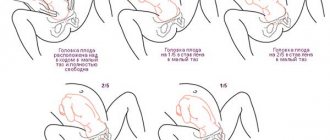Artificial opening of the membranes, or amniotomy, often causes some concerns among women expecting the birth of a baby. Not every patient in the maternity ward understands the meaning of this procedure: why open the amniotic sac if the waters break on their own during labor? Let's try to reassure expectant mothers and answer this question.
Based on the objectives and timing of the procedure, amniotomy is divided into three types. Premature amniotomy is used to induce labor. During childbirth, there may be a need for early or late amniotomy.
What happens if the membranes rupture before contractions?
In some cases, labor begins with the rupture of water. Moreover, it can be complete or partial. According to statistics, such a deviation can occur in 12% of all women. This process is called premature rupture of amniotic fluid.
Women immediately notice this phenomenon, especially if it happens with a large amount of water.
The amniotic fluid should be light or pink and odorless. If black, brown or green color is mixed with it, this means that there is feces of a newborn in the waters. This indicates that the fetus has experienced oxygen starvation, which requires rapid delivery. An admixture of yellow color may indicate the presence of a Rh conflict, which also requires quick action.
When the water breaks at home, the woman in labor must urgently go to the maternity hospital. In the hospital, the woman must accurately report the time of their departure.
If the body is completely ready for the birth of a child, contractions begin immediately or some time after the water breaks.
Carrying out amniotomy. Progress of the procedure
After treating the external genitalia, the doctor inserts the index and middle finger into the uterine os of the cervix until it comes into contact with the amniotic sac. During childbirth, this is usually done at the height of contraction with the greatest tension in the amniotic sac when manually applied by pressing the bladder from bottom to top or using an instrument with With a sharp hook at the end, the membranes are opened, after which the obstetrician uses his fingers to spread the membranes apart. The manipulation is painless, because there are no nerve endings in the membranes.
At the time of amniotomy, the doctor evaluates the color of the water: this sign can be used to judge the condition of the fetus. Normally, the waters are clear, but if the waters are green, this indicates that the baby is experiencing a lack of oxygen, which, in turn, leads to relaxation of the intestinal obturator muscles, and the original feces mixes with the amniotic fluid. Yellow amniotic fluid indicates a disease that develops in the fetus when the blood of the mother and fetus is incompatible according to Rhesus or blood group.
Fortunately, serious complications from amniotomy are rare. However, this manipulation may be accompanied by undesirable consequences: pain and discomfort, infection, deterioration of the fetal heartbeat, prolapse of the umbilical cord or small parts of the fetus (arms or legs), as well as bleeding from the fetal vessels in the membranes, from the cervix or from the placenta attachment site (partial abruption placenta).
Opening the amniotic sac is used only when necessary; the manipulation is carried out with the consent of the woman. Since, as already mentioned, the amniotic sac plays a protective role, including protecting the fetus and uterus from infection, no more than a day should pass from the moment the amniotic fluid is released until the baby is born. Currently, time restrictions have become even more stringent, and it is believed that a more reliable protection against infection of the fetus and uterus is a water-free period of no more than 12 hours.
Why is the amniotic sac needed? The importance of amniotic fluid is great. They prevent the formation of adhesions between the membranes and the fetus; protect the umbilical cord and placenta (baby place) from pressure from large parts of the fetus and uterine contractions during childbirth; make fetal movements possible and easy, which are necessary for its proper development; protect the fetus from shocks and bruises from the outside; influence the position and articulation of the fetus - the relative position of the limbs and torso; make fetal movements less noticeable for the pregnant woman; the integrity of the fetal bladder protects against infection and promotes the opening of the uterine pharynx during childbirth - during each contraction, the fetal bladder wedges into the cervical canal, facilitating the opening of the cervix. Normally, opening of the membranes occurs when the cervix is more than 6 cm dilated.
What is amniotomy?
Amniotomy is an operation in which the amniotic sac is opened. In utero, the fetus is protected by a special membrane - the amnion, which is filled with amniotic fluid. It protects the child from shocks and infection from the vagina.
If an opening or rupture occurs naturally, the uterus begins the process of expelling the fetus. As a result, contractions develop and the baby is born.
The operation to puncture the bladder before childbirth without contractions is carried out with a special device in the form of a hook at the moment of its greatest severity, so as not to affect the soft tissues of the baby’s head.
What is this process?
Amniotomy is one of the ways to induce labor. During the procedure, the doctor punctures the amniotic sac, causing the amniotic fluid to drain and the process of contractions to begin or intensify.
Usually the waters pour out during childbirth on their own, but about 7% of women still need such a procedure. After the puncture, part of the water located in front of the baby’s head leaves, irritation of the birth canal occurs, which helps to intensify contractions.
Also, when the water is released, the expectant mother begins to produce the hormone prostaglandin, which enhances the contractions of smooth muscles, thereby stimulating contractions.
Some women are afraid of amniotomy during childbirth - this is completely in vain. It is safe for mother and child, and is done only when indicated. Amniotomy, judging by reviews, is completely painless; it does not require any means of pain relief.
Conditions for the procedure
Performed in approximately 7% of all births
Despite the fact that the procedure for opening the amniotic sac is quite simple and does not require the presence of a surgeon, it still requires some conditions.
- The procedure should only be performed by an obstetrician-gynecologist in a hospital setting.
- The cervix must be fully prepared for the birth process.
- The baby must take the correct position, and his head must be in the correct position in the pelvis of the woman in labor.
- Amniotomy without contractions should be carried out only if all of the above conditions are met for the given indications.
If all the conditions for the procedure are met, the amniotomy is carried out according to indications and the manipulation technique is followed, the likelihood of negative consequences will be very small.
Indications for manipulation
The procedure is performed according to indications, and not at the request of the doctor or woman in labor. There is a specific list of reasons for carrying out this procedure.
- Preeclampsia, accompanied by severe swelling, increased blood pressure, and increased protein content in the urine.
- Post-term pregnancy, when labor does not begin until 41-42 weeks.
- Weak labor.
- Placental insufficiency.
- The bubble shell is too dense.
- Rh conflict between mother and child.
There are also indications for early amniotomy.
- Flat amniotic sac, i.e. lack of anterior waters.
- Low position of the placenta.
- Polyhydramnios.
- High blood pressure in the mother.
Quite often the procedure is done for twins, since in this case there is often a weakening of labor. The need for this should be assessed by a doctor during the birth process.
Types of procedure
In total, there are 4 types of amniotomy, the technique does not change, and the difference lies only in the timing of the manipulation.
| Type of procedure | The essence of the procedure |
| Prenatal | Prenatal amniotomy is performed before the onset of contractions in order to start the birth process. This is done in case of post-term pregnancy or in the presence of certain pathologies, when it is preferable for the health of the child to induce labor prematurely. |
| Early | Performed during the initial stage of labor, when the cervix is open no more than 7 cm. Early amniotomy is indicated in case of weak and irregular contractions. |
| Timely | It passes when the cervix is almost completely open, 8-10 cm, but the bubble has not yet burst on its own. |
| Late | With late amniotomy, the baby's head is already in the pelvis, and the second, pushing stage of labor begins. As a rule, the bladder ruptures on its own, but sometimes the intervention of a gynecologist is required. |
Late amniotomy is performed if the membrane is too dense, and the child cannot rupture it on his own during the birth process. It is considered the most dangerous, since it has the highest probability of hitting the baby’s head.
However, it is necessary to carry out it, otherwise the most severe consequences for the health of the newborn are possible - he may face hypoxia and suffocation. The most favorable time for a puncture is considered to be the period of contractions, since at this time the amniotic sac is clearly visible.
How is the manipulation carried out?
This is a safe and painless procedure, since the bladder does not have any nerve endings
Both planned and regular amniotomies are performed in exactly the same way. The procedure does not cause the woman any unpleasant sensations, so she should not be afraid of it. However, it must be remembered that in order to carry it out, the doctor must obtain the consent of the woman in labor, and also inform her about all the possible consequences.
Amniotomy is performed according to the following algorithm.
- Before the operation, the doctor checks the condition of the fetus.
- Next, on the obstetric chair, the gynecologist assesses the condition and degree of dilatation of the cervix.
- If the cervix is in the desired condition, the doctor inserts a plastic hook into the uterus.
- During a contraction, when the wall of the bladder protrudes, the doctor carefully pierces it.
- Then, using your finger, carefully widens the hole and releases amniotic fluid.
- In the next 30 minutes, the woman in labor should be under observation, the condition of the fetus is monitored using CTG.
You can learn more about how amniotomy is performed by watching a video recording of this procedure.
Contraindications for carrying out
Performed only if there are significant indications for its implementation.
Despite the simplicity of this operation, sometimes it may be contraindicated. An experienced doctor will never puncture the bladder if at least one of the following factors is present:
- malposition;
- presentation of umbilical cord loops;
- complete placenta previa.
Autopsy of the amniotic sac is not performed if the woman in labor has viral infections. These include:
- genital herpes;
- immunodeficiency virus;
- hepatitis.
When carrying out manipulation, the risk of infection of the child increases, so gynecologists prefer to protect the baby from possible disease.
In addition, the amniotic sac is never pierced if a woman has contraindications for natural childbirth. Currently, the indications for caesarean section are:
- scars on the uterus;
- pathological conditions of the birth canal;
- high fetal weight;
- placental abruption;
- retinal tears;
- fundus changes;
- 3rd degree tears during previous births;
- acute fetal hypoxia according to CTG data.
Possible complications
Like any medical operation, it has its complications.
If the operation is performed correctly, there are practically no complications after it. This method is considered completely safe for the child and mother, unless there are any contraindications. However, in extremely rare cases when a woman undergoes an amniotomy, the following risks may occur:
- umbilical cord prolapse: in this case, acute hypoxia may develop in the baby, so urgent surgical intervention during the birth process is required;
- damage to a large vessel of the fetal bladder: for this reason, bleeding occurs, which can threaten the life of the child;
- rapid labor: this is possible due to a sharp change in pressure in the uterus, which can lead to rupture of the cervix and perineum;
- if the puncture does not lead to increased labor, then after a certain time it is necessary to use other methods of stimulation, since without protection in the form of an amniotic sac, there is a danger of infection of the uterus and fetus.
Some women categorically refuse to puncture the amniotic sac, forgetting that only a qualified specialist is able to correctly assess the need for a particular obstetric intervention. Find out what it is.
By refusing this procedure due to prejudice or unreasonable fears, you can seriously harm both yourself and your child. Therefore, listen to the doctor’s opinion - do not risk the life and health of your own child.
Thanks 0
In utero, the child is protected by a special membrane - the amnion, filled with amniotic fluid. They protect it from shock when moving, and the shell prevents the upward penetration of infection from the vagina.
During childbirth, the baby's head is pressed against the cervix and a fetal bladder is formed, which, like a hydraulic wedge, gradually stretches the cervix and forms the birth canal. Only after this does it break on its own. But there are situations when the bladder is punctured before childbirth without contractions.
This procedure is not prescribed at the request of the woman or the whim of the doctor. Successful amniotomy is possible if certain conditions are met:
- the fetal head is presented;
- full-term pregnancy of at least 38 weeks with one fetus;
- estimated fetal weight more than 3000 g;
- signs of a mature cervix;
- normal pelvic size;
- There are no contraindications for natural childbirth.
Types of amniotomy
Bladder puncture before childbirth can be divided into several types, depending on the time of the operation:
- Prenatal. It is carried out before contractions occur to induce labor.
- Early. It is performed if the opening of the cervix is up to 7 cm.
- Timely. If the cervix is open to 8-10 cm.
- Belated. Can be carried out at the time of expulsion of the fetus. The procedure is used to prevent hypoxia in the fetus or bleeding in the mother.
The process of childbirth does not change at all and corresponds to nature. The condition of the fetus is necessarily recorded using a CHT apparatus.
When is amniotomy necessary?
Labor is stimulated by puncturing the bladder in case situations arise where emergency delivery is required. The procedure can be carried out in the absence of contractions:
- Post-term pregnancy. A normal pregnancy lasts 40 weeks; if it is longer, then the question of the need for obstetric care is raised. In this situation, the placenta ages and cannot perform its functions. As a result, the child suffers, experiencing oxygen starvation.
- Preeclampsia. This disease is characterized by swelling, high blood pressure and the presence of protein in the urine. Preeclampsia negatively affects the health of the mother and fetus, so an amniotomy is needed.
- Rhesus conflict. Such a pregnancy is considered difficult, so this operation helps stimulate labor.
If labor has begun, then surgery is resorted to in the following cases:
- Weakness of labor. If the contractions do not intensify, but weaken, the cervix slows down the labor process, and to prevent them from stopping, the bladder is punctured. The woman in labor is observed for 2 hours; if there is no positive dynamics, then a decision is made to resort to Oxytocin.
- Polyhydramnios. The presence of a large amount of amniotic fluid leads to the fact that the uterus cannot contract naturally.
- High blood pressure. Kidney and heart diseases, gestosis contribute to increased blood pressure, which negatively affects the birth process and the condition of the fetus.
- Flat amniotic sac. In this situation, the anterior waters are almost completely absent, which makes labor difficult, and its cessation may occur.
- Low location of the placenta. This position of the placenta can lead to abruption and bleeding.
In some cases, there are contraindications for this procedure.
Mandatory stage or last resort: why do an amniotomy?
Nature has programmed it so that the discharge of amniotic fluid during childbirth occurs without outside intervention. Normally, the bubble bursts when the cervix is almost completely dilated and the baby is ready to leave the mother’s tummy. But in reality, many women undergo an artificial bladder puncture before giving birth. Such manipulations are usually resorted to if contractions are already in full swing, pushing will soon begin, but the water has not yet broken.
The intention to shorten the duration of delivery is the first answer to the question of why the bladder is pierced before childbirth. It is believed that amniotomy improves labor, makes it possible to do without stimulation, and examine the amniotic fluid for the presence of meconium or blood.
This practice flourishes in maternity hospitals, but it should be understood that this is an optional procedure. Amniotic fluid helps open the cervix, serves as a kind of “safety bag” for the baby - it softens the pressure and pain that he has to experience during contractions, facilitates movement through the birth canal (therefore the head is less deformed), and reduces the likelihood of intrauterine infection.
Are there any contraindications?
Puncture of the bladder before childbirth helps to facilitate the process of giving birth, but in some cases there are some limitations of the procedure. Amniotomy is not performed if:
- a pregnant woman has herpes on the genitals in the acute stage;
- the placenta is low;
- umbilical cord loops interfere with surgery;
- natural childbirth is not recommended;
- finding the fetus in oblique, transverse and breech presentation.
The procedure is prohibited if the mother has heart disease, if there are scars on the cervix and other pathologies.
Who can't?
Contraindications to this procedure are: herpes on the perineum, complete placenta previa, foot, pelvic, oblique or transverse position of the fetus, an umbilical cord loop on the head, a weak scar on the uterus after cesarean section, tumors, narrowing of the pelvis, the baby’s weight is more than 4.5 kg, deformation of the vagina due to scar changes, high myopia, triplets, stage 3 fetal growth retardation, acute hypoxia.
How is a bladder punctured?
Why and how do they puncture the bladder before childbirth? Amniotomy is equivalent to surgery, but the presence of an anesthesiologist and surgeon is not necessary. After a vaginal examination, the doctor opens the bladder. The procedure includes several stages:
- Before the operation, the woman takes No-Shpu or another antispasmodic. After exposure to the medicine, the woman lies down on the gynecological chair.
- Then the specialist, wearing gloves, inserts the instrument into the vagina. The amniotic sac is hooked and pulled by the doctor until it ruptures. After this, the amniotic fluid begins to flow out.
- After the end of the manipulation, the woman remains in a horizontal position for 30 minutes. The condition of the fetus is monitored by a CHT device.
The bubble necessarily opens in the absence of contractions, which leads to the convenience and safety of the operation.
How does a woman feel during an amniotomy?
Bladder puncture before childbirth - painful or not? Any woman is afraid of such a procedure because of the possible pain. However, in this case, no unpleasant sensations are observed, because the amniotic sac has no nerve endings.
A woman just needs to relax and take a comfortable position. All she can feel after a correctly performed procedure is only the leakage of amniotic fluid.
When muscles are tense, discomfort and negative consequences may occur in the form of injury to the vaginal walls.
Is it painful for a woman in labor?
Most women are interested in whether it hurts to pierce the bladder (see also: is it painful to give birth or not?). There is no pain during an amniotomy (for more details, see the article: amniotomy - what is it?). This is due to the absence of nerve endings on the bladder. The woman feels the release of water without discomfort. Pain can occur when the vaginal muscles are very tense, so the woman in labor needs to take a comfortable position and relax as much as possible.
After the woman returns to normal, she should walk more to speed up contractions. As a rule, they become active within a few hours. If this does not happen, drug stimulation is used, since prolonged exposure of the fetus without water leads to oxygen starvation. How long does it take to give birth after surgery? The first birth (for first-time mothers) lasts from 8 to 14 hours, the second – 5-10 hours.
Prerequisites
What are the conditions for puncturing the bladder before childbirth? To avoid complications during the procedure, you must follow some rules. These include:
- correct presentation of the fetus (cephalic);
- pregnancy, the duration of which is at least 38 weeks;
- natural delivery and no restrictions on this;
- preparedness of the birth canal;
- pregnancy with one fetus.
The importance lies in the readiness and maturity of the uterus. When performing an operation, it must correspond to 6 points on the Bishop scale.
Complications and consequences of amniotomy
If the bladder is punctured correctly before childbirth, the entire process occurs safely. But there are a few exceptions, where after an amniotomy labor may become more difficult. There are the following consequences:
- injuries to the umbilical cord vessel if it is attached to the membrane, which can lead to blood loss;
- the child’s condition worsens;
- umbilical cord loops or fetal limbs (arms, legs) fall out;
- abnormal heartbeat of the child;
- rapid labor activity;
- secondary birth weakness.
There is a risk that puncture of the amniotic sac will not lead to the desired result and labor will not become active. Therefore, doctors resort to using drugs that cause contractions. In some situations, a woman undergoes a caesarean section, because the child’s prolonged stay without water is fraught with negative consequences.
How long does labor last after puncture of the bladder before childbirth? Reviews from women who have gone through this procedure are as follows:
- in women who gave birth for the first time, labor took place within 7-14 hours;
- for multiparous women, this may take 5-12 hours.
Any intervention, which includes puncture of the bladder, sometimes leads to consequences that are not always positive. Amniotomy should be carried out in compliance with all necessary conditions, which will reduce the risk of complications of various types. Therefore, if this procedure is necessary, women should not refuse surgery and other manipulations necessary during childbirth.
How long does labor last after a puncture?
The procedure directly affects the duration of labor in the case of.
Main features:
- the neck is open at least halfway, that is, 5 fingers;
- it is smooth and short.
Then the puncture will contribute to its rapid opening to the end, and therefore bring the birth closer. A few hours maximum – and the baby will be born. If stimulation with hormonal drugs is required, labor will be longer.
The main thing is that the child should not be without water for more than 12 hours. This is exactly the task facing maternity hospital workers and mothers.











